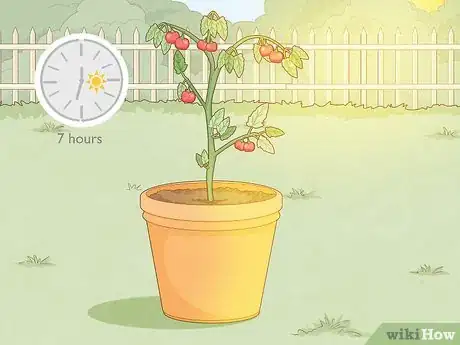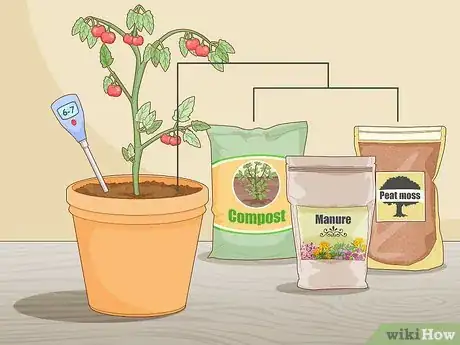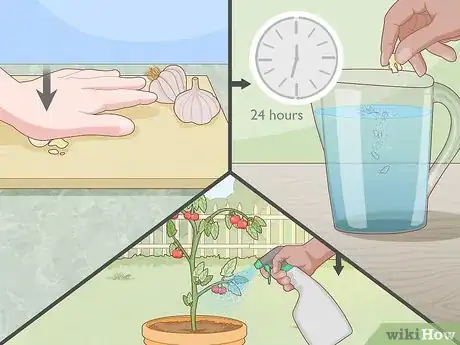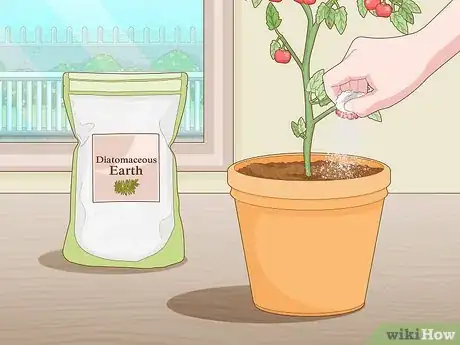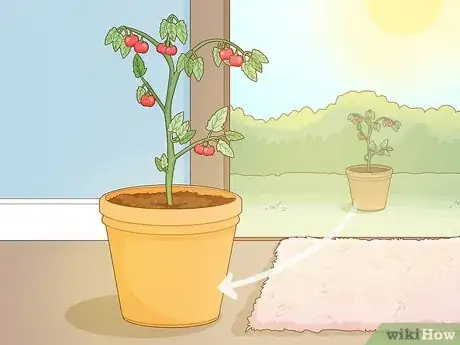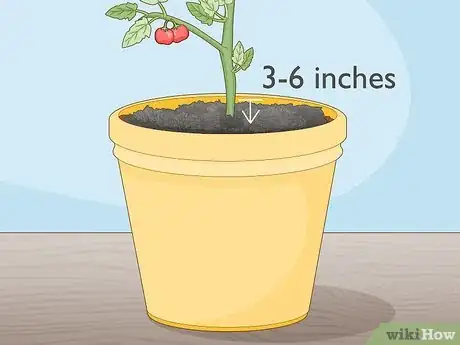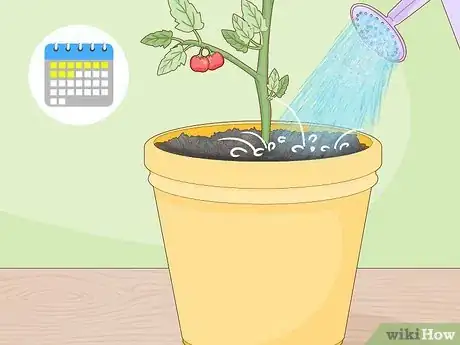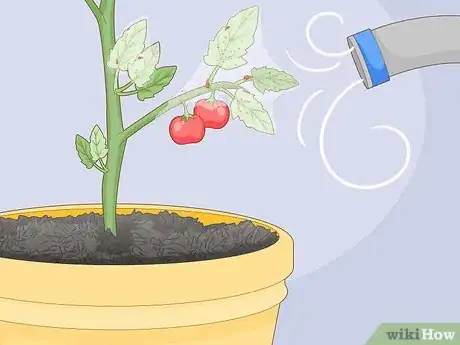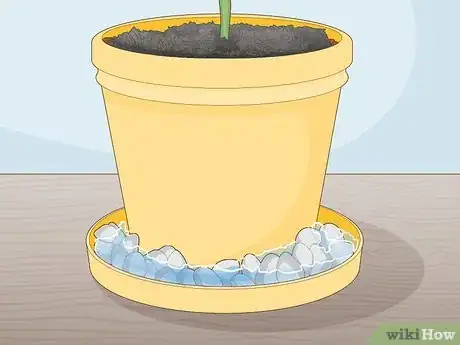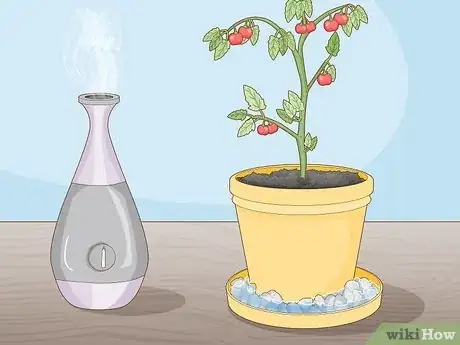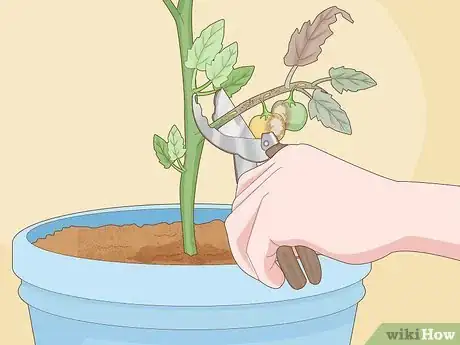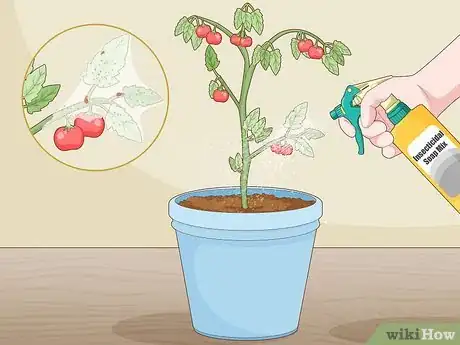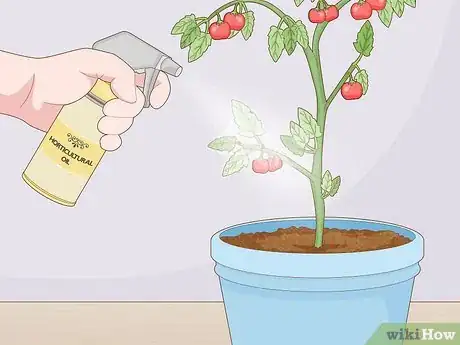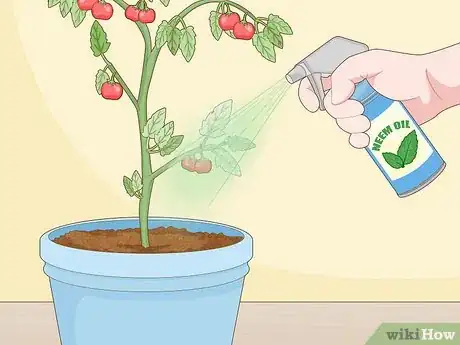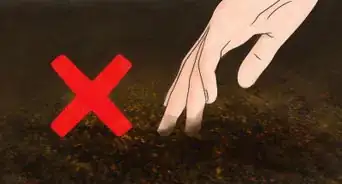This article was co-authored by Chikezie Onyianta. Chikezie Onyianta is a Pest Control Specialist and the Owner of EcoFusion Pest Control, serving communities in New Jersey, Pennsylvania, and New York. With over 5 years of experience, he specializes in pest control in both residential and commercial spaces. A graduate of Essex County College, Chikezie and EcoFusion assist in rodent, roach, and ant pest control as well as bed bug services.
There are 9 references cited in this article, which can be found at the bottom of the page.
wikiHow marks an article as reader-approved once it receives enough positive feedback. In this case, 100% of readers who voted found the article helpful, earning it our reader-approved status.
This article has been viewed 125,667 times.
Spider mites are annoying and tiny arachnids that can infest and damage many kinds of outdoor plants, including tomatoes. Spider mites prefer hot and dry conditions, therefore, keep your tomato plants well hydrated and out of the hot afternoon sun. You can also use your hose to keep spider mites off your tomato plants or to get rid of them if they’ve already become a problem.
Steps
Keeping Spider Mites Away
-
1Plant your tomato plants where they stay warm without drying out. Tomato plants need at least 7 hours of sunlight every day to grow successfully. Plant your tomatoes outside in a location that gets enough sunlight, but isn’t in the direct path of the afternoon sun. Tomato plants that are in the perfect environment, with sufficient sunlight and moisture, will be much less likely to develop a spider mite infestation. Also consider planting your tomatoes in a location where they can take advantage of radiant heat, such as next to large boulders or a building.[1]
- If planting your tomatoes in a pot, take advantage of the fact that you can move those pots if required. Move the pots into the morning sun each day, then move them out of the direct afternoon sun to prevent them from drying out.
-
2Ensure your tomato plants are growing in loamy soil with lots of organic matter. In general, tomato plants aren’t overly fussy when it comes to the soil, however, the proper soil conditions will help ensure the soil stays moist and will not create conditions where spider mites may thrive. Plant your tomato plants in soil that is loamy, with lots of organic matter (compost, peat moss, or manure).[2]
- The pH level of the soil for tomato plants should be between 6.0 and 7.0.
- If you’re planting your tomatoes in pots, use high-quality vegetable potting soil to preserve soil moisture. Also, use vegetable fertilizer in your pots to provide your tomato plants with sufficient nutrients.
Advertisement -
3Place hot pepper or garlic in the soil to prevent spider mites. Spider mites are not fans of hot peppers or garlic. When planting your tomatoes (either in your garden or in a pot/container), spray the soil under the plants with homemade hot pepper or garlic spray to keep spider mites away and prevent them from harming your tomato plants.[3]
- For the hot pepper spray, add 1 teaspoon (4.9 mL) of cayenne pepper flakes to 1 cup (240 mL) of water in a spray bottle. Shake the bottle to mix the ingredients and allow them to sit for at least 24 hours before using it.
- For the garlic spray, add 2 mashed garlic cloves to 1 litre (4.2 c) of water in a bowl or jug. Allow the mixture to sit for 24 hours and then strain out the garlic pieces. Put the mixture into a spray bottle to use.
-
4Apply diatomaceous earth to the soil around your tomato plants. Purchase food-grade diatomaceous earth (D.E.) from a garden centre, hardware store, or online. Sprinkle the D.E. on the soil, in unbroken rings, around your tomato plants. You can also sprinkle or dust the D.E. directly onto the leaves of your tomato plants. Spider mites will not attempt to cross the D.E. barrier around the plants, but you do need to reapply D.E. after it’s rained or you’ve soaked the plants.[4]
- D.E. is the powdered fossilized skeletons of microscopic organisms called diatoms. It is a mined substance that is found in areas where lakes were present millions of years ago.
- Do not apply any D.E. to the flowers on your tomato plants. D.E. doesn’t distinguish between good and bad insects and may harm pollinators if applied to the tomato plant flowers.
-
5Move your tomato plants indoors to protect them if you can. If you’ve planted your tomatoes in pots, you can move them indoors for a variety of reasons. First, it will be easier to control the humidity around your plants when they’re indoors. Second, having your tomato plants indoors may help you prevent and/or control spider mites.[5]
- If only some of your tomato plants are infested with spider mites, keep them outside and move the uninfested plants indoors to protect them.
- If all of your tomato plants are infested with spider mites, spray down the plants with a hose before moving them inside. Once indoors, keep the tomato plants away from any other plants you may have.
Deterring Mites with Moisture
-
1Use black mulch to preserve soil moisture for your tomatoes. Once planted, apply a layer of black mulch (3 to 6 inches (7.6 to 15.2 cm)) on top of the soil around your tomato plants. You can add mulch to both gardens and pots. The mulch will keep the soil moist, but will also help control weeds and prevent ground rot.[6]
- You can use commercial mulch that comes in plastic bags from a garden centre, or you can use straw.
- When laying the mulch on the ground, keep a 1 in (2.5 cm) space around the stem of your tomato plants to prevent fungal problems.
-
2Soak your tomato plants every 7-10 days to prevent rot. Watering your tomato plants frequently and lightly can cause tomatoes to crack or the blossoms of the plants to rot. It can also allow the development of foliage disease. Soak the soil around your tomato plants every 7 to 10 days instead. When soaking your tomatoes, spray the undersides of the leaves with your hose to remove any initial spider mites that may have started to make a home.[7]
- If the soil around your tomato plants is drying out before your next watering day, increase the frequency of the soaking.
- Tomatoes planted in pots may need to be soaked more frequently, as pots tend to dry out faster.
-
3Use a hose to remove spider mites from your plants.[8] The spray from an outdoor hose is of a high enough pressure to help keep spider mites from being able to make a home on your tomato plants. Spray your tomato plants with a hose, especially on the undersides of the leaves, on a weekly basis. This spray will help keep spider mites away and will also water your tomato plants.[9]
- This method can be used on tomatoes planted in a garden and planted in pots.
- Be careful that the spray of water isn’t too strong that it damages the tomato plants.
- You may want to use the nozzle and spray upwards on the plants to get the undersides of the leaves. Or, hold the leaves with your hands and turn them over before spraying them.
-
4Keep a layer of water in your pot saucers to increase soil moisture. Spider mites hate moist conditions. To help prevent spider mites on your tomato plants, ensure there is always a layer of water in the tray or saucers in which your tomato pots or containers are sitting. This water will keep the soil moist, which in turn, should help keep spider mites away.[10]
- This method will only work for tomato plants in pots. However, if you put your tomato plants in a garden, you can leave buckets or pots of water in and around your plants to increase the general moisture around your tomatoes.
- This is especially important when the conditions are hot and dry. Tomato plants that are water-stressed are more susceptible to spider mite infestations.
-
5Install a humidifier close to your tomato plants to increase the moisture level. Cluster your potted tomatoes together on a porch or deck and place a humidifier in the middle of the cluster. Keep the humidifier going during the driest parts of the day. If your tomato plants are indoors, put the humidifier anywhere in the same room as the plants.[11]
- Remember to check the reservoir of the humidifier frequently and keep it full of water.
Controlling an Infestation
-
1Cut off and remove parts of your tomato plants that are infested. Once an infestation has progressed, you may need to resort to more drastic measures. If you notice specific parts of your tomato plants appear bleached or bronzed, or if the leaves have started to curl, cut those pieces off using garden shears.[12]
- Dispose of the infected portions of your tomato plants in the garbage or by burning them. Do not put them in your compost pile or you may spread the infestation to other plants in the future.
-
2Spray insecticidal soap on tomato plants to kill spider mites. Purchase a commercially-made insecticidal soap at a garden centre or hardware store or make your own. Spray the soap onto your tomato plants, making sure to focus the spray on the undersides of the leaves where spider mites live. Reapply the soap again if you see continuing evidence of spider mites on your tomato plants.[13]
- Make your own insecticidal soap by combining 1 teaspoon (4.9 mL) of mild liquid soap (such as castile soap) to 1 litre (4.2 c) of lukewarm (slightly warm) water in a spray bottle. Shake the spray bottle before using the soap.
- Do not use insecticidal soap on tomato plants that are water-stressed or when the temperatures are higher than 90 °F (32 °C).
-
3Apply horticultural oil to your tomato plants to eliminate spider mites. Some highly refined oils are considered superior or horticultural oils. Spray the oil directly onto your tomato plants, especially on the undersides of leaves. The oil will essentially drown the spider mites without damaging the tomato plant. Make sure you read the manufacturer’s instructions before using the oil.[14]
- Superior or horticultural oils are non-toxic, which means they will impact bad insects (like spider mites), but should not impact beneficial insects (like those that eat spider mites).
- These oils are designed not to harm the plant itself if used properly. It is important to read the manufacturer’s instructions to ensure you do not damage your tomato plants.
- Do not use superior or horticultural oils on tomato plants that are water-stressed or when the temperatures are higher than 90 °F (32 °C).
-
4Use neem oil to control and prevent spider mites.[15] Purchase concentrated neem oil from a garden centre, hardware store, or online. Combine 1.5 teaspoons (7.4 mL) of neem oil concentrate to 1 teaspoon (4.9 mL) of mild liquid soap (such as castile soap) and 1 litre (4.2 c) of lukewarm (slightly warm) water in a spray bottle. Shake the bottle to mix the ingredients and spray directly onto your tomato plants, specifically on the undersides of the leaves.[16]
- Neem oil spray can take a while to work on spider mites. To give it the best chance to work properly, wipe off the leaves (with a sponge or cloth) of your tomato plant first to remove as many spider mites as possible.
- Neem oil spray can also be used as a preventative measure if sprayed on tomato plants regularly once leaves have formed.
Community Q&A
-
QuestionHow do you tell if a web was made by a spider mite?
 Community AnswerSpider mites produce very small webs that almost hug the plant's leaves. If you look closely, you can also see tiny white mites crawling along the webs.
Community AnswerSpider mites produce very small webs that almost hug the plant's leaves. If you look closely, you can also see tiny white mites crawling along the webs. -
QuestionWill Sevin 5 dust kill the mites?
 NinoxTop AnswererNot sure. Spider mites develop resistances to pesticides, and Sevin 5 is maybe too weak to get rid of mites.
NinoxTop AnswererNot sure. Spider mites develop resistances to pesticides, and Sevin 5 is maybe too weak to get rid of mites. -
QuestionHow long do I need to wait after spraying my tomatoes with Daconil if I have discovered spider mites?
 NinoxTop AnswererDaconil has a very long active length. It will be effective for 24 to 28 days.
NinoxTop AnswererDaconil has a very long active length. It will be effective for 24 to 28 days.
Warnings
- Keep in mind that not all solutions provided are considered organic. If you are trying to grow organic tomatoes, officially or unofficially, many of these options should not be used. Refer to a website such as the Organic Materials Review Institute (OMRI) at https://www.omri.org/home for more information on which products can and cannot be used for organic gardening.⧼thumbs_response⧽
- Spider mite eggs can survive the winter on dead and fallen leaves and twigs. That is why it’s important to destroy any infected plants, as spider mites can survive in your compost pile.[17]⧼thumbs_response⧽
- When spraying soaps or oils, or spreading diatomaceous earth, wear protective equipment such as eyewear and a mask. While they are not necessarily toxic to humans, they can be irritating to your eyes or lungs.[18]⧼thumbs_response⧽
References
- ↑ https://catalog.extension.oregonstate.edu/ec1333/html
- ↑ https://catalog.extension.oregonstate.edu/ec1333/html
- ↑ https://plantcaretoday.com/get-rid-spider-mites.html
- ↑ https://www.almanac.com/news/gardening/gardening-advice/what-diatomaceous-earth
- ↑ https://www.pests.org/how-to-get-rid-of-spider-mites/
- ↑ https://catalog.extension.oregonstate.edu/ec1333/html
- ↑ https://catalog.extension.oregonstate.edu/ec1333/html
- ↑ Chikezie Onyianta. Pest Control Specialist. Expert Interview. 1 April 2021.
- ↑ https://www.missouribotanicalgarden.org/gardens-gardening/your-garden/help-for-the-home-gardener/advice-tips-resources/pests-and-problems/insects/mites/spider-mites-outdoors.aspx
- ↑ https://extension.umd.edu/hgic/topics/spider-mite-vegetables
- ↑ https://getbusygardening.com/control-spider-mites/
- ↑ https://www.missouribotanicalgarden.org/gardens-gardening/your-garden/help-for-the-home-gardener/advice-tips-resources/pests-and-problems/insects/mites/spider-mites-outdoors.aspx
- ↑ https://getbusygardening.com/control-spider-mites/
- ↑ https://www.missouribotanicalgarden.org/gardens-gardening/your-garden/help-for-the-home-gardener/advice-tips-resources/pests-and-problems/insects/mites/spider-mites-outdoors.aspx
- ↑ Chikezie Onyianta. Pest Control Specialist. Expert Interview. 1 April 2021.
- ↑ https://getbusygardening.com/control-spider-mites/
- ↑ https://www.rhs.org.uk/advice/profile?pid=190
- ↑ https://www.almanac.com/news/gardening/gardening-advice/what-diatomaceous-earth
About This Article
Spider mites can infest and damage your outdoor tomato plants, but you can keep them away with a few simple tricks. Tomato plants need at least 7 hours of sunlight every day, but keeping them out of the afternoon sun will help keep spider mites away. If your plants are in pots, move them into the morning sun but out of the afternoon sun, or plant your tomatoes in a spot where they’ll mainly get the less drying morning heat. Another way to deter spider mites is to place hot pepper or garlic in the soil. Spray the soil under the plants with a mixture of cayenne pepper flakes and water or mashed garlic cloves and water. When watering your plants, soak the soil around them every 7 to 10 days. When hosing down the soil, spray the undersides of the leaves too to remove any mites that may have started to infest the area. To learn how to use neem oil to control and prevent spider mites, keep reading!
